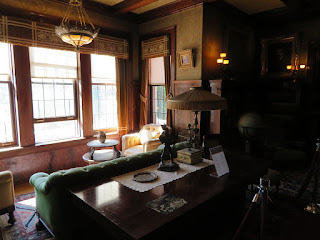After finishing our route 61 tour of Minnesota, it
was time for us to start heading home.
We wanted to find a route home that would allow us to visit an area we
had not been to before. Looking at our
scenic road trip book, it seemed that a drive along the north shore of
Wisconsin east of Duluth was such a drive.
I must say that most of that drive was not scenic unless you consider
mile after mile of empty roads and some woods scenic. When we rounded the hook
of Wisconsin and headed south, we finally found scenic. This was the start of the Apostle Island
area. The center of this area is the
small town of Bayfield, WI.
Once again, we arrived without a reservation This
area was also full of tourists. Just north of Bayfield , we were able to get a spot in the campground owned by the
native American Red Cliff Band group of Ojibwa.
Long story short, this group had occupied the islands until in 1816 the government
claimed them and allowed lumbering and other commercial enterprises to operate
on the islands. Finally, when the Ojibwa people were pushed into ever smaller
areas and to avoid additional conflict, the government granted them and other
groups the mainland shoreline nearest
the islands. So we were camped along the
shore on land owned by some of the earliest settlers of the offshore
islands. In studying the history here, I
also found it amazing that there is some evidence that some humans were here as
early as 100BC. It is also thought that
a group known as the Anishinaabe people lived here by 950 AD.
In 1970 ,The Apostle Island National Lakeshore was
established and includes 21 of the 22 islands and 12 miles of the shoreline. The
largest island, Madeline, is not part of the national park and is mostly
devoted to tourism including a state park.
The plan for the lakeshore was to return them to, as
close as possible, to their natural state. In order to do this, those who lived
and worked here since 1816 would have to leave. Unlike the native Americans,
they were given at least some better treatment.
The land would be purchased by the
federal government. There were some who resisted
this process and under a compromise, would be allowed to live on the islands
until they passed away and the land then would revert to the federal government.
Today, the Apostle Islands has a diverse plant and
animal environment for visitors to enjoy. Over 800 types of plants, animals, the greatest
concentration of black bears in North
America and many bird groups. You can
access the islands by national park approved vendors and private vessels. Kayaking is very popular and visiting the famous
sea caves. There is also camping and hiking on the islands.
We decided on the grand tour which passes all of the
islands and provides a narration of the
important features of each.
Bayfield is also worth a visit. We picked up some great
smoked fish. One local thought it compares to Annapolis, MD for sailing.











































































